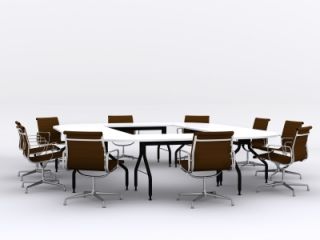Career
Do Collaborative Workspaces Work?
Workspace design exerts a powerful effect on behavior — for better or worse.
Posted November 25, 2012
A few weeks ago, I was invited to lunch with a steering committee at my university whose mission was to design the interior of a new addition to their building. These days, I think of myself more as an explorer of spatial behavior on urban-scale rather than as an interior design expert, but I think that many of the ways in which the grammar of spaces influence how we think and feel scale seamlessly from the interior of a home to the wide expanse of a city, so I accepted their offer with only a little bit of trepidation that I might have little to offer them.

Image courtesy of nookhoog_buchachon, FreeDigitalPhotos.net
In preparation for the meeting, I spent some time familiarizing myself with the latest news and ideas about workspace design. In some ways, what I found didn’t surprise me. We’re still gaga about Google and plumping for Pixar. We’d all like to find ways to make our workplaces free, open and filled with toys like pinball machines and ping-pong tables. Apparently, we’d most like our offices to be open marketplaces filled with heady, creative encounters with workmates, uniquely shaped seating places in primary colors, chatter, hubbub, toys and, of course, lots of free food. A quick browse through the Internet would suggest that this is the way to make happy, dedicated, satisfied and incredibly creative employees.
As I read through the glowing accounts of workspace transformations and their near miraculous effects on worker happiness and creativity, I had a funny recollection of an encounter that I’d had at a party about a year ago. Sometime before the party, I’d been asked to comment for an article on workspace design for a national newspaper and, as I recall, I’d given a measured response to the reporter’s questions about the effects of such re-vampings in offices, suggesting that it was certainly possible to affect behavior by manipulating the size and shapes of our spaces, and that it seemed reasonable to suppose that a savvy designer could use walls, windows, and furniture to change how we worked. My remarks were a minor footnote in an article that was mostly in support of the positive changes that were said to be effected by open office designs. A woman at the party who had read the article and recognized my name accused me of colluding with a crusade to open up office space. This crusade, she argued, was making many working lives miserable. Her own office space had been recently transformed, and she complained of the lack of privacy, the noise, and an inability to carry out her work routines in a way that was comfortable for her. So this recollection, along with an Internet that seems awash in arguments for such transformations, led me to scratch a little deeper below the surface, and to try to find out what the scientific literature on workplace design had to say about open and collaborative office designs.
My first surprise here was that such a literature is surprisingly lacking. There’s certainly no shortage of articles on workplace design, lists of tips, and accounts of glowing accolades and awards for designers. But what actually happens to office employees after such re-designs? Are they happier? More comfortable? More productive? More creative? It turns out that we’re not sure yet, but what is known suggests that simply trashing the cubicles and putting tables and chairs on wheels in a large, empty space is too clumsy an approach to succeed.
It’s certainly true that throwing office workers into a melting pot of shared space is likely to increase the number of interactions between workers who might not normally have a chance to talk to one another, and those of us who talk about the effect of space on behavior repeat like a mantra that sometimes such interactions are where creative ideas are born. But what’s important to know is what kinds of interactions are desired in a particular organization. Here’s a simple example from one of the workspaces in my home: the kitchen. My kitchen is small. The counters are really designed so that the space works reasonably well for one person to prepare a meal. But the kitchen is located in such a way that it’s also a major transit hub in my house. It’s the south end of Main Street, in a way, so you have to walk through it to get to a few of the other major parts of the house’s living space. This means that when I’m making dinner for my family, I normally experience a few unplanned encounters with other people, often accompanied by my cries of “Not there!”, “Hot dish behind you!”, “I can’t open the fridge!” These encounters occasionally give rise to some creative vocabulary on my part but not to creative ideas. The moral here is simple: it’s very easy to organize a space in such a way that it draws a crowd, but sometimes a crowded space is the last thing you need to complete the task at hand. Sometimes we need sole occupation of our space. Good workspaces need to have affordances that allow solitary workers to complete a task without disturbance.
Here’s another example of the effect of space on behavior, taken from another part of my house: the dining table. When we all sit down for dinner together (yes, this happens sometimes even though I have teenagers!), we have assigned seating. I sit at the head of the table not so much for the heavy Paterfamilias effect as for convenience—this position puts me closest to the kitchen and I’m typically the one who is running back and forth with the food. But this seat is also the one that affords the best visibility of the whole house. I can see the main hallway, two of the doors, and the entryway into every room on the main floor. This grand overview makes my chair the envy of all members of the family, which means that on less formal occasions than the grand tucking into Tuesday’s Tuna Casserole, such as homework, game, or snack time, there is a buzz of competition for my seat. What this suggests about workplaces where there are no assigned spaces for workers is that even if there is a general understanding that nobody “owns” space, workers will be well aware of the prized locations within the environment and they will compete and try to stake claims to these locations whether with careful deliberation or simply by following their impulses. Again, the moral is simple: human beings are complicated social and territorial animals; even if we place them into an open and level playing field, they will self-organize, self-group, and vie for favored places. Good office designs need to take such matters into account and not treat employees like autonomous widgets (albeit wildly creative ones) who will simply disperse into a space randomly like avatars in an elaborate video game.
In light of staggering changes in the world of work, there is every reason to re-consider office design. The traditional layout of corner offices with windows surrounding a matrix of cubicles is a scheme that was born in a bygone era using borrowed thinking from assembly lines in factories. It is entirely unsuitable for many modern companies, especially those in knowledge or creative industries. But I fear that what may be happening is that the old assembly line style of office is being replaced with a new style of workspace that tries to make our physical environment resemble something like the Internet where, in a sense, all occupants are in the same flat, wide-open space together. But although the Internet may be the ultimate collaborative workspace, it’s not real in the same way that an office building with walls, doors and windows is real. In cyberspace, we can be anywhere and everywhere at once and we can all share a single node with hundreds of others without bumping elbows, blocking access to the fridge, or commandeering a favored location with the best views. But real people are not just nodes in a network. We are living and breathing animals who feel emotions, get hungry, need privacy, and are prone to lapses of attention when distracted. This part of the office space equation cannot be neglected.
In the end, the most important advice I would offer to anyone considering a new office design would be to make sure you know what it is that your organization accomplishes now, and how it does so. Take the time to actually study your workflow. Question your employees. Collect and analyze actual data. If you’re not sure how to do this, find someone who is. Decide what is working and what needs improving and only then start to think about how a re-design of your workspace might produce the changes you desire.
The shape and design of a space can be an extremely potent catalyst for bringing about positive changes in a work organization, but it takes circumspection. Simply wading in using a generic list of designer tips might produce positive change, but it’s just as likely to lead to disaster.
Suggested reading
Follow me on Twitter




